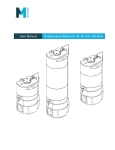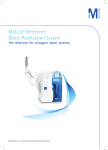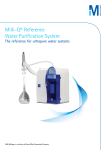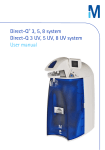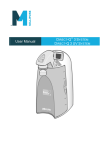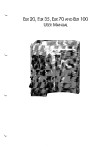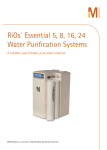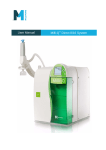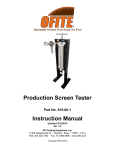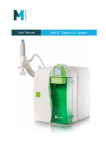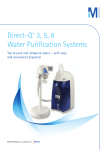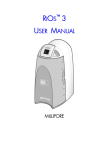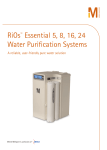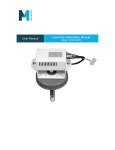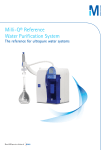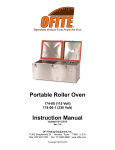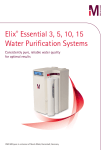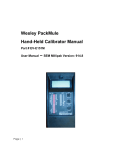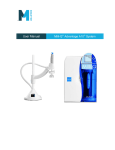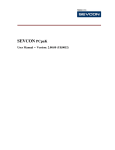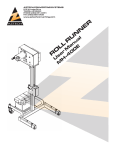Download Membrane Research
Transcript
POLYETHYLENE RESERVOIR 30, 60 AND 100 LITERS USER MANUAL MILLIPORE Notice The information in this document is subject to change without notice and should not be construed as a commitment by Millipore Corporation. Millipore Corporation assumes no responsibility for any errors that might appear in this document. This manual is believed to be complete and accurate at the time of publication. In no event shall Millipore Corporation be liable for incidental or consequential damages in connection with or arising from the use of this manual. Copyright © 1998 MILLIPORE CORPORATION. PRINTED IN FRANCE. ALL RIGHTS RESERVED. THIS BOOK OR PARTS THEREOF MAY NOT BE REPRODUCED IN ANY FORM WITHOUT THE WRITTEN PERMISSION OF THE PUBLISHERS. Section 1 Documentation Rev. D - 03/06 Trademarks Millipore, Elix, Milli-Q and Millipak are registered trademarks of Millipore Corporation. RiOs is a trademark of Millipore Corporation. All other trademarks are trademarks of their respective manufacturers. TABLE OF CONTENTS Chapter 1 Introduction.......................................................................................1 1-1 USING THIS MANUAL ................................................................................................................. 1 1-2 CONTACTING MILLIPORE ............................................................................................................. 1 Chapter 2 Product Information...........................................................................2 2-1 MAIN COMPONENTS ................................................................................................................ 2 2-2 TECHNICAL SPECIFICATIONS ......................................................................................................... 3 Chapter 3 Unpacking the Reservoir − What’s Inside? ........................................4 Chapter 4 Installation and set-up of the Reservoir .............................................5 4-1 FILLING THE RESERVOIR WITH WATER ................................................................................................ 5 4-2 GETTING WATER FROM THE RESERVOIR ............................................................................................. 5 4-3 LEVEL SENSOR ASSEMBLY ............................................................................................................. 5 4-4 VENT FILTER ............................................................................................................................. 6 4-5 OVERFLOW TUBING AND CHECKVALVE ............................................................................................ 6 Chapter 5 Maintenance......................................................................................7 5-1 MAINTENANCE OF THE OVERFLOW TUBING ...................................................................................... 7 5-2 STORING THE RESERVOIR FOR A LONG PERIOD OF TIME ........................................................................... 7 5-3 SANITIZING THE RESERVOIR .......................................................................................................... 8 Chapter 6 Ordering information ........................................................................9 6-1 CATALOGUE NUMBERS FOR RESERVOIRS ........................................................................................... 9 6-2 CATALOGUE NUMBERS FOR CONSUMABLES ...................................................................................... 9 6-3 CATALOGUE NUMBERS FOR ACCESSORIES ........................................................................................ 9 -i- INTRODUCTION Chapter 1 INTRODUCTION 1-1 USING THIS MANUAL This User Manual is a guide for use during the installation, normal operation, and maintenance of a 30, 60 or 100 Liter PE Reservoir. ‘Reservoir’ is used in this manual to refer to the 30 Liter PE Reservoir, the 60 Liter PE Reservoir, or the 100 Liter PE Reservoir unless otherwise noted. It is highly recommended to completely read this manual and to fully comprehend its contents before attempting normal operation or maintenance of the Reservoir. 1-2 CONTACTING MILLIPORE INTERNET The Millipore Internet Site can be used to find addresses, telephone/fax numbers, and other information. Internet Site Address: www.millipore.com www.millipore.com/techservice MANUFACTURING SITE Millipore SAS 67120 Molsheim FRANCE -1- PRODUCT INFORMATION Chapter 2 PRODUCT INFORMATION 2-1 MAIN COMPONENTS Level Sensor Tank Cap Flat Gasket with Cap Reservoir Front Ball valve Reservoir Base Overflow Tubi ng Reservoir feed port 1/4 inch FNPT Ball valve 1/2 inch FNPT Ball valve Check Valve -2- PRODUCT INFORMATION 2-2 TECHNICAL SPECIFICATIONS DIMENSIONS 392 (15.5) 697 (27.5) Tank 30 l 937 (36.9) Tank 60 l 1357 (53.4) Tank 100 l 415 (16.3) 382 (15) 214 (8.4) 351 (13.8) 190 (7.5) 703 (27.7) Tank 30 l 943 (37.2) Tank 60 l 1367 (53.7) Tank 100 l -3- 703 (27.7) Tank 30 l 943 (37.2) Tank 60 l 1367 (53.7) Tank 100 l UNPACKING Chapter 3 UNPACKING THE RESERVOIR − WHAT’S INSIDE? Open the Reservoir Shipping Box. Use the checklist below to make sure all items were shipped and are accounted for. It is highly suggested to become familiar with the items that are shipped since these will be used in the Installation section of this manual. Contact Millipore if an item is missing. Reservoir and base Front ball valve Level Sensor cable with jack connector Lid Reservoir feed port ª inch ball valve ∞ inch ball valve Overflow Tubing and check valve In the Accessories Bag Length of Overflow Tubing 6 mm straight tubing connector Red plug for tubing connector The following items are NOT INCLUDED WITH THE RESERVOIR and need to be ordered separately: Vent Filter Connector fittings for the feed water tubing Feed water tubing to connect to a water system -4- INSTALLATION Chapter 4 INSTALLATION AND SET-UP OF THE RESERVOIR 4-1 FILLING THE RESERVOIR WITH WATER The other end of this tubing is secured to the source of water filling the Reservoir. The Reservoir feed water tubing can be cut to allow installation of a 6 mm straight tubing connector. The tubing is pushed into the two ends of the connector. Normally the connector is installed near the Water Purification System. The connector fitting is used later when the flow rate of product water from the Water Purification System needs to be measured. To do this, remove the tubing at the connector coming from the Water Purification System. Use the red plug, to plug the open end of the connector. This prevents the Reservoir from emptying. > 100 cm 4-2 GETTING WATER FROM THE RESERVOIR Bring the end of a piece of tubing through the large hole in the back of the base. Connect the end of this tubing to the ª inch Female National Pipe Thread (FNPT) ball valve (A). It will be necessary to first place a fitting to this ball valve. This fitting is not supplied with the Reservoir. The ∞ inch FNPT ball valve (B) can be used for applications needing large amounts of water quickly (dishwasher). This valve can be also used to completely drain the Reservoir of water. A B 4-3 LEVEL SENSOR ASSEMBLY The Level Sensor assembly is intended to be used with a Water Purification System to display the amount of water in the Reservoir. During shipping, the Level Sensor float is secured to the Level Sensor rod. Remove the lid to view the Level Sensor rod and float. It is necessary that the plastic clip is removed and that the float can move freely up and down the Level Sensor rod. ATTENTION The magnet on the float points up for proper operation. If it is reversed, then the displayed levels of water in the Reservoir will be incorrect. -5- INSTALLATION 4-4 VENT FILTER A Vent Filter should be used to filter any air entering the Reservoir. As the Reservoir is being emptied of water, the air entering the system is filtered through the Vent Filter. It is important that the Reservoir is airtight by securing the lid and that the check valve on the Overflow Tubing is installed (see below). This allows the air to only go through the Vent Filter. There are two different Vent Filters available. The catalogue number and description of these Vent Filters are: TANKMPK01. This Vent Filter is used when the Reservoir is fed with Elix product water. This Vent Filter contains activated carbon, soda lime and a 0.65 micron (μm) hydrophobic membrane. This Vent Filter is replaced every time the Elix system Progard pre-treatment pack is replaced. See the Elix/RiOs operating manual for further information regarding Progard pack replacement. TANKMPK02. This Vent Filter is used when the Reservoir is fed with RiOs reverse osmosis product water. This Vent Filter contains two 0.65 (μm) hydrophobic membrane discs inside. This Vent Filter is replaced once-a-year for best results. TO INSTALL EITHER TYPE OF VENT FILTER: The plug on the coupling must be removed at installation. The Vent Filter is mounted to a coupling connector at the top front of the Reservoir. The thread on the Vent Filter does not need to be taped since there is a small rubber gasket on the coupling. The Vent Filter should be turned until it stops against the gasket. Do not over tighten it. ATTENTION Do not throw away the Vent Filter coupling when the Vent Filter is replaced. The Vent Filter has two side vent ports. These are not used. 4-5 OVERFLOW TUBING AND CHECKVALVE The Overflow Tubing is connected between the Reservoir and a check valve (C). The check valve prevents air from entering the Reservoir through the Overflow Tubing. A Connect the Overflow Tubing to the Reservoir. The end of the Overflow Tubing (B) is connected to a stem on the back of the Reservoir (A). B It is desirable to have at least 45 or more cm vertical distance between the top of the Reservoir and the check valve. C ATTENTION The check valve has a proper orientation. The check valve is oriented so that water can flow out the Overflow Tubing but air can not flow up through the Overflow Tubing into the Reservoir. 45 cm -6- MAINTENANCE Chapter 5 MAINTENANCE 5-1 MAINTENANCE OF THE OVERFLOW TUBING The Overflow Tubing should be periodically checked for water inside of it. If there is water inside of it, then the tubing should be disconnected from the back of the Reservoir. Discard the water in the Overflow Tubing and place the Overflow Tubing back on the Reservoir. The Overflow Tubing should be sanitized whenever the Vent Filter is replaced or at least a few times a year. The Overflow Tubing can be sanitized with bleach (sodium hypochlorite 5% solution) or with household strength hydrogen peroxide (~ 1.5% solution). The Overflow Tubing should be replaced if it becomes discolored. 5-2 STORING THE RESERVOIR FOR A LONG PERIOD OF TIME The reservoir should be drained if it is not used for over one week. The inner wall of the reservoir should be dry during storage -7- MAINTENANCE 5-3 SANITIZING THE RESERVOIR The Reservoir can be sanitized either through the use of sanitizing chemicals or through the use of an Ultraviolet (UV) light. CHEMICAL SANITIZATION ATTENTION Disconnect any equipment fed by the Reservoir (Milli-Q® systems, dishwashers...). Disconnect the ASM if your Reservoir uses one. 1. Fill the reservoir with product water from a Water Purification System. Disconnect the feed water source from the reservoir by plugging the reservoir feed water tubing connector with the plug. 2. Add enough to obtain a concentration of 100 ppm in the Reservoir. For example, if you are using an 11.4% Sodium Hypochlorite solution, use the following amounts of bleach: 26 ml for a 30 l tank, 52 ml for a 60 l tank, 88 ml for a 100 l tank. ! HAZARD ATTENTION The Sodium Hypochlorite will form a strong chemical solution when mixed with water. This solution can be very dangerous for your eyes and for your skin. Wear Eye Safety Glasses and Laboratory Gloves and other appropriate safety equipment . Do not add a chlorine tablet to the reservoir. If you do not use an 11.4% Sodium Hypochlorite solution, please contact Millipore for a procedure suitable to your application. 3. Open the valves at the front and at the bottom of the Reservoir for a few seconds in order to sanitize them also. 4. Let the Reservoir soak for at least 12 hours. At the end of this period completely drain the reservoir through the ½ inch ball valve located at the bottom of the reservoir. Connect the feed water source to the reservoir and allow the reservoir to fill. 5. Drain and refill the reservoir twice. 6. Reconnect the equipment fed by the Reservoir and replace the Tank Vent Filter. 7. Reconnect the ASM if your Reservoir uses one. Note: The frequency of sanitization varies depending on use and application. It is recommended to sanitize the Reservoir at least once a year, if possible at the end of summer. ULTRAVIOLET SANITIZATION An Automatic Sanitization Module (ASM) could be used in order to prevent the formation of bio film and the proliferation of bacteria inside the Reservoir. The module makes use of the germicidal properties of Ultra-Violet (UV) light at 254 nm produced by a mercury lamp fitted into the reservoir. The lamp is held in a lid which replaces the existing reservoir closure. The ASM UV lamp can be turned on one or more times during the day. Contact Millipore for further information regarding the ASM. -8- ORDERING INFORMATION Chapter 6 ORDERING INFORMATION 6-1 CATALOGUE NUMBERS FOR RESERVOIRS Description Catalogue Number 30 L Polyethylene Reservoir TANKPE030 60 L Polyethylene Reservoir TANKPE060 100 L Polyethylene Reservoir TANKPE100 6-2 CATALOGUE NUMBERS FOR CONSUMABLES Description Catalogue Number Advanced Vent Filter (Recommended for Elix® water storage) TANKMPK01 Standard Vent Filter (Can be used for RiOs™ water storage) TANKMPK02 6-3 CATALOGUE NUMBERS FOR ACCESSORIES Description Catalogue Number Wall mounting bracket TANKFIX01 Automatic Sanitization Module (230 V/50Hz) TANKS50UV Automatic Sanitization Module (230 V/50Hz) with Water Sensor TANKS5LUV Automatic Sanitization Module (120 V/60Hz) TANKS60UV Automatic Sanitization Module (120 V/60Hz) with Water Sensor TANKS6LUV Distribution Pump (230 V/50 Hz) and Connection Kit TANKREC50 Distribution Pump (120 V/60 Hz) and Connection Kit TANKREC51 -9-













